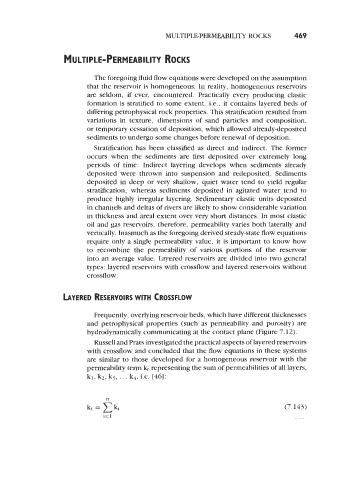Page 501 - Petrophysics
P. 501
MULTIPLE-PERMEABILITY ROCKS 469
MULTIPLE- PERMEABI LITY ROCKS
The foregoing fluid flow equations were developed on the assumption
that the reservoir is homogeneous. In reality, homogeneous reservoirs
are seldom, if ever, encountered. Practically every producing clastic
formation is stratified to some extent, it., it contains layered beds of
differing petrophysical rock properties. This stratification resulted from
variations in texture, dimensions of sand particles and composition,
or temporary cessation of deposition, which allowed already-deposited
sediments to undergo some changes before renewal of deposition.
Stratification has been classified as direct and indirect. The former
occurs when the sediments are first deposited over extremely long
periods of time. Indirect layering develops when sediments already
deposited were thrown into suspension and redeposited. Sediments
deposited in deep or very shallow, quiet water tend to yield regular
stratification, whereas sediments deposited in agitated water tend to
produce highly irregular layering. Sedimentary clastic units deposited
in channels and deltas of rivers are likely to show considerable variation
in thickness and areal extent over very short distances. In most clastic
oil and gas reservoirs, therefore, permeability varies both laterally and
vertically. Inasmuch as the foregoing derived steady-state flow equations
require only a single permeability value, it is important to know how
to recombine the permeability of various portions of the reservoir
into an average value. Layered reservoirs are divided into two general
types: layered reservoirs with crossflow and layered reservoirs without
crossflow.
LAYERED RESERVOIRS WITH CROSSFLOW
Frequently, overlying reservoir beds, which have different thicknesses
and petrophysical properties (such as permeability and porosity) are
hydrodynamically communicating at the contact plane (Figure 7.12).
Russell and Prats investigated the practical aspects of layered reservoirs
with crossflow and concluded that the flow equations in these systems
are similar to those developed for a homogeneous reservoir with the
permeability term kt representing the sum of permeabilities of all layers,
kl, k2, k3, . . . kq, i.e. [46]:
n
kt = ki (7.143)
i= 1

